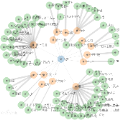Incorporating knowledge graph (KG) into recommender system is promising in improving the recommendation accuracy and explainability. However, existing methods largely assume that a KG is complete and simply transfer the "knowledge" in KG at the shallow level of entity raw data or embeddings. This may lead to suboptimal performance, since a practical KG can hardly be complete, and it is common that a KG has missing facts, relations, and entities. Thus, we argue that it is crucial to consider the incomplete nature of KG when incorporating it into recommender system. In this paper, we jointly learn the model of recommendation and knowledge graph completion. Distinct from previous KG-based recommendation methods, we transfer the relation information in KG, so as to understand the reasons that a user likes an item. As an example, if a user has watched several movies directed by (relation) the same person (entity), we can infer that the director relation plays a critical role when the user makes the decision, thus help to understand the user's preference at a finer granularity. Technically, we contribute a new translation-based recommendation model, which specially accounts for various preferences in translating a user to an item, and then jointly train it with a KG completion model by combining several transfer schemes. Extensive experiments on two benchmark datasets show that our method outperforms state-of-the-art KG-based recommendation methods. Further analysis verifies the positive effect of joint training on both tasks of recommendation and KG completion, and the advantage of our model in understanding user preference. We publish our project at https://github.com/TaoMiner/joint-kg-recommender.
翻译:将知识图( KG) 纳入推荐人系统, 将知识图( KG) 纳入推荐人系统是大有希望的, 提高建议准确性和解释性。 但是, 现有方法在很大程度上假定 KG 是完整的, 简单地在实体原始数据或嵌入器的浅层次上传输 KG 中的“ 知识” 。 这可能导致业绩不优化, 因为实用的 KG 很难完成, 并且通常KG 缺少事实、 关系和实体。 因此, 我们争辩说, 当将 KG 纳入推荐人系统时, 考虑 KG 的不完整性质至关重要。 在本文件中, 我们共同学习了建议和知识图的完成模式。 与以前基于 KG 的优势建议方法不同, 我们转让关系信息, 以便了解用户喜欢的项目。 举例来说, 如果一个用户看过由( 关系) 同一人( 实体( ) 所指导的电影, 我们就可以推断, 主任关系在用户做出决定时发挥着关键的作用, 从而帮助理解用户对精细的用户偏好。 技术上, 我们为新的基于翻译的建议模型的建议模型模型模型, 我们用KG 将KG 的进度分析方法, 然后用两种方法 将K 将各种的完成方法 基级的进度转换为K, 基基级的 基级的进度 基级的进度 基级 基级 基级 基级分析方法,, 向两个基级的 基级的 基级 基级 基级 基级 基级 基级 基级 基级 基级 基级 基级 基级 基级 基级 基级 基级 基级 基级 基级, 的 基级 基级 基级 基级 基级 基级 基级 基级 基级 基级 的 的 的 基级 基级 基级的 基级 基级 基级 基级 基级 基级 的 基级 基级 基级 基级 基级 基级的 的 基级 的 基级 基级 基级的 的 基级 基级 基级的 基级的 的 的



